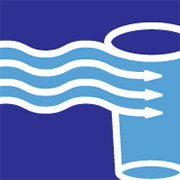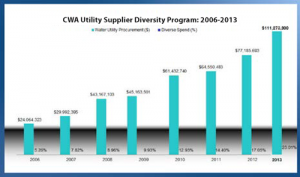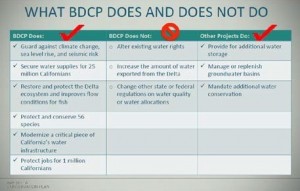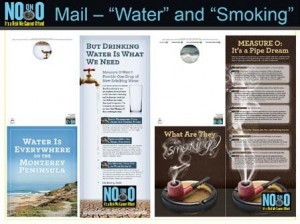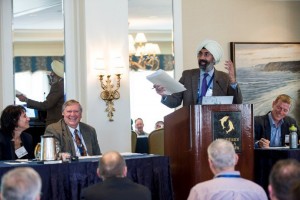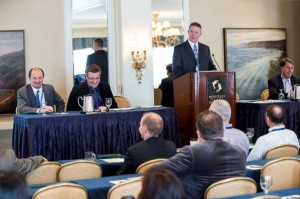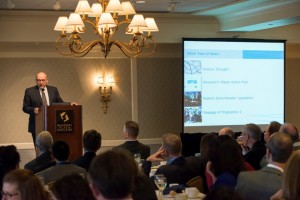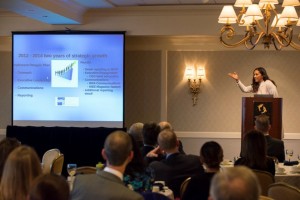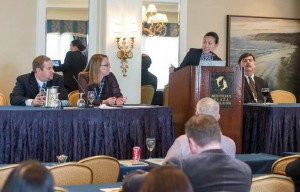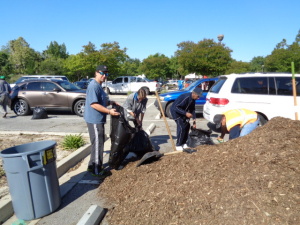With great attendance and a strong program, California Water Association (CWA) members and water industry experts met in Monterey on November 12-14 for CWA’s 73rd Annual Conference to share challenges and successes in addressing California’s drought and other water-related issues. Centered on the theme, “Baking Bad, Sustaining Good,” the conference featured a variety of presentations and panel discussions on local conservation efforts, innovative solutions to the drought and more.
R.W. Nicholson, President, San Gabriel Valley Water Company and 2013-14 CWA President, greeted conference attendees with an update of CWA’s 2014 accomplishments and work on water conservation/drought management, public information, water quality, legislative and regulatory advocacy, small company assistance and the supplier diversity program. Nicholson concluded his remarks by handing off the 2015-16 CWA presidency to Greg Milleman, Director of Field Administration and Finance, California Water Service Company.
Sacramento Bee Columnist Dan Walters provided the keynote address, “California Water and the 2014 Election,” and cited the old adage, “nothing focuses the mind like facing death.” With water at the top of the political agenda, Walters observed that the drought focused the minds of policymakers and the public on water and paved the way for the passage of Proposition 1, the statewide water bond. Walters noted that CWA members can tap into Proposition 1’s $7.5 billion for improving California’s water supply and quality, and he predicted a reshuffling of water rights and legislation on groundwater regulation. According to Walters, water and healthcare will dominate the agenda at the Capitol for the foreseeable future. He concluded, “Water will be in our face all the time for our lifetimes.”
CWA Executive Director Jack Hawks moderated the first panel on “Tipping Points between Voluntary Conservation, Mandatory Restrictions and Rationing.” Panelists included Rami Kahlon, Director, California Public Utilities Commission (CPUC) Division of Water and Audits; Kurt Schwabe, Associate Professor of Environmental Economics and Policy, University of California, Riverside; and Caren Trgovcich, Chief Deputy Director, State Water Resources Control Board (SWRCB). Panelists discussed the public policy issues, drought conditions, timing and tipping point milestones that state regulators must consider when deciding to move from voluntary conservation measures to mandatory restrictions on water use. These included reservoir levels at less than half of normal, the loss of agricultural land and jobs, communities running out of drinking water, wells drying up, wildfire threats and environmental damage to waterways and wildlife.
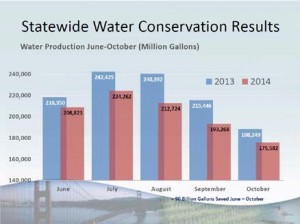 The panel also compared price versus non-price approaches to conservation such as education, rebates and mandatory restrictions. Despite the governor’s “Drought State of Emergency Proclamation,” the SWRCB’s mandatory restrictions and the CPUC’s water conservation resolutions, the drought continues to put pressure on policy officials and the public to do more. The panelists indicated that if the drought continues through 2015, it’s likely the tipping point will move from voluntary conservation and mandatory restrictions to outright rationing.
The panel also compared price versus non-price approaches to conservation such as education, rebates and mandatory restrictions. Despite the governor’s “Drought State of Emergency Proclamation,” the SWRCB’s mandatory restrictions and the CPUC’s water conservation resolutions, the drought continues to put pressure on policy officials and the public to do more. The panelists indicated that if the drought continues through 2015, it’s likely the tipping point will move from voluntary conservation and mandatory restrictions to outright rationing.
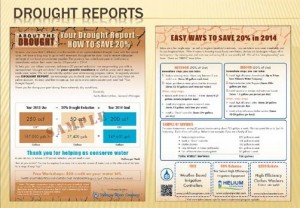 “Water Police – Does Tattling on Your Neighbor Really Work?” was the focus of the second panel, including Matt Dickens, Resource Conservation Manager, Valencia Water Company; Toby Goddard, Administrative Services Manager, Santa Cruz Water Department; and Patrick Pilz, Manager of Conservation and Efficiency, California American Water; with moderator Greg Milleman. Participants described methods of encouraging conservation beyond turning in water abusers and concluded outreach and education work well. One example is a Drought Response Integration Plan (DRIP), which includes annual reports sent to customers comparing their water consumption with the 20 percent reduction target and offers conservation tips. Customers also can monitor their real-time water usage online.
“Water Police – Does Tattling on Your Neighbor Really Work?” was the focus of the second panel, including Matt Dickens, Resource Conservation Manager, Valencia Water Company; Toby Goddard, Administrative Services Manager, Santa Cruz Water Department; and Patrick Pilz, Manager of Conservation and Efficiency, California American Water; with moderator Greg Milleman. Participants described methods of encouraging conservation beyond turning in water abusers and concluded outreach and education work well. One example is a Drought Response Integration Plan (DRIP), which includes annual reports sent to customers comparing their water consumption with the 20 percent reduction target and offers conservation tips. Customers also can monitor their real-time water usage online.
Some water companies employ field staff to check for water waste, while others offer online reporting or rely on water waste hotlines or call centers. The panel discussed consequences for violations, which range from a soft approach (we’re here to help you) to repeated notices to tiered penalties up to disconnection of service. Although penalties serve as an effective deterrent, most cases are resolved with a single contact. The panel concluded that tattling does not work as well as being proactive about water waste education and providing good customer service, with success measured by the gallons of water saved rather than the number of citations issued.
The morning’s final presentation by Andrew Ulmer, Senior Director, Client Solutions, WaterSmart Software, addressed “Behavioral Science, Big Data and Conservation.” Ulmer explained how behavioral science and big data from automating processes through technology to deliver meaningful output can be combined to deliver easy, targeted and measurable conservation programs. He described how WaterSmart Software offers a way to educate and engage customers through a turnkey, cloud-based engagement, analytics and behavioral water efficiency solution. WaterSmart’s technology can personalize information to each customer and is capable of targeting communication, integrating multiple data sources, tracking customer satisfaction and engagement and sending real-time notices and e-alerts.
Lester Snow, Executive Director, California Water Foundation and former Secretary of the California Natural Resources Agency, presented the keynote luncheon address on “Entering a Fourth Year of Drought: Has California Become the Australia of the 2000s?”
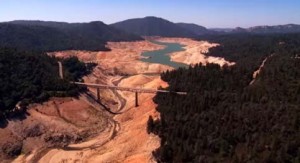
After providing a brief history of drought in California and actions taken by the governor and regulators in 2014, Snow discussed issues and opportunities for 2015. These include ongoing drought response measures, implementation of the Sustainable Groundwater Management Act of 2014 (SGMA) and Proposition 1, the Bay Delta Conservation Plan and federal policy shifts.
He illustrated how the drought monitor plan changed dramatically during the past 12 months and expressed concern about the conditions of statewide reservoirs, particularly Pine Flat and Exchequer with current levels at 12 and 7 percent respectively. Snow noted the reservoirs will not be filled next year, which will drive policy discussions. He addressed groundwater supplies, predicting 65 percent of the state’s water will come from groundwater by year end, which is well over the 35-40 percent pumped in normal years. Snow explained the complexities of the SGMA and encouraged water utilities to take an active role in its implementation and the water bond’s implementation.
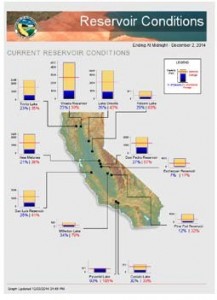 |
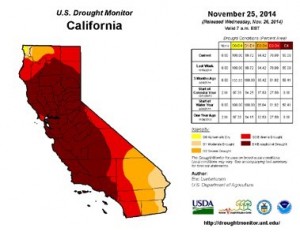 |
Following lunch, Charmaine Jackson, Chair of CWA’s Utility Supplier Diversity Program (USDP) Committee, and Manager of Supplier Diversity and Community Affairs for San Jose Water Company, provided an update on CWA’s supplier diversity program since its inception in 2006. The Committee’s efforts have set new standards for diverse supplier excellence in the water utility industry’s supply chain through the companies’ partnerships with community-based organizations and professional organizations serving women-, minority- and disabled-veteran-owned businesses. With 469 diverse businesses participating with CWA member water companies, the USDP continues to realize cost savings and positive impacts on job creation and on local economies. In 2013, CWA member companies participating in the USDP spent more than $111 million with diverse businesses, a 23.01 percent increase over 2012. The Mentor Protégé Program also was launched in 2013 to assist potential vendors with capacity-building and technical assistance, and both California Water Service Company President and CEO Marty Kropelnicki and Golden State Water Company Vice President of Regulatory Affairs Keith Switzer represented CWA at the California Public Utility Commission’s annual En Banc Hearing on supplier diversity in October.
Given the significant role of the Sacramento-San Joaquin River Delta (Delta) in statewide water management, Janet Barbieri, Program Manager, Bay Delta Conservation Plan (BDCP) Public Outreach and Education Program, gave a status report on the BDCP. Governor Brown’s Water Action Plan highlights priorities for key areas, including the Bay Delta as part of an overall solution. Barbieri said the BDCP is a long-term strategy guided by the best available science that will secure water supplies, create jobs and boost the economy, enhance the environment and restore the health of the Delta and its ecosystem, including plants, fish and wildlife. With partial recirculation of the draft Environmental Impact Report/Environmental Impact Statement expected in 2015, Barbieri encouraged conference attendees to “stay involved!” Updates are available at www.baydeltaconservationplan.com.
Speaking about “A New Culture for Drinking Water in California,” Cindy Forbes, Deputy Director, Division of Drinking Water, State Water Resources Control Board (SWRCB), gave an overview of the Division of Drinking Water’s transition to the SWRCB. She outlined the responsibilities of the Division, the systems under its regulation, its field operations and the organizational structure. Forbes explained pending and recently adopted regulations, funding programs and policy changes, as well as the Division’s role in natural disasters such as earthquakes, wildfires, floods and the drought. She reviewed the new application process and announced major changes to the safe drinking water ranking categories.
For IOUs facing eminent domain takeovers of water systems, California American Water (CAW) shared lessons learned from an extensive outreach campaign to defeat this year’s ballot Measure O, which was an attempt to have the Monterey Peninsula Water Management District condemn and take over CAW’s Monterey water system district. Company consultant Michael Terris, Principal, Terris, Barnes & Walters, described the campaign in his presentation, “Monterey’s No on O: It’s a Risk We Cannot Afford.”
Paid for by CAW’s owners, the outreach campaign focused on CAW’s stewardship of the local environment and its strong emphasis on the community and customer service. A key theme was the risk to the community if it took over the district by eminent domain. The campaign relied on a variety of outreach methods, including mailers, bill inserts, email blasts, print and television ads, YouTube videos and Facebook and Google ads. In addition, teams of local supporters of CAW knocked on almost 50,000 doors to communicate the primary messages.
Terris shared lessons learned such as: conducting early polling and focus group sessions to establish a clear road map; creating a detailed campaign plan; starting early to maintain control of the measure’s implications for voters; controlling the dialogue; and staying disciplined with the campaign’s primary message points.
The program ended with a panel on “Innovative Water IOU Responses to the Drought” with panelists Bob Day, Director of Customer Service, San Jose Water Company (SJWC), Ken Jenkins, Conservation Manager, California Water Service Company (Cal Water), Darleen Phares, Water Conservation Manager, Suburban Water Systems (Suburban), and Tiffany Tran, Conservation Coordinator, San Gabriel Valley Water Company (SGVWC), who also moderated the panel.
SJWC’s actions included: frequent bill inserts; postings on websites and social media; meetings with customers, community leaders and the media; partnerships with local stakeholders and universities; using advanced technology, including real-time data, to work with high water users; and on-site investigations and water audits.
Cal Water launched a school education program, Cal Water H2O Challenge, to inform, engage and motivate students to care about water and make a positive difference in their communities. The free classroom competition for grades four through six requires a portfolio with project goals, research, actions, community outreach, student reflections and teacher reflections. Various prizes were awarded, including a grand prize classroom tent camping trip to the Channel Islands with NatureBridge.
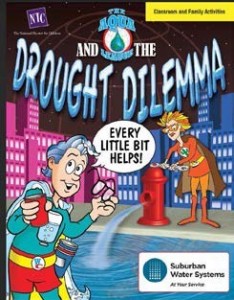 Suburban partnered with the National Theatre for Children from Minneapolis to perform half-hour plays at local schools focused on water conservation, pollution and what students can do to save water. Reaching almost 10,000 students each year, the performances and classroom activities are a great way to provide conservation messages to customers through their children.
Suburban partnered with the National Theatre for Children from Minneapolis to perform half-hour plays at local schools focused on water conservation, pollution and what students can do to save water. Reaching almost 10,000 students each year, the performances and classroom activities are a great way to provide conservation messages to customers through their children.
SGVWC’s conservation programs included education and public outreach, such as the National Theatre for Children and public events, as well as commercial and industrial instructional programs on indoor/outdoor school retrofits and turf removal. A residential program included the distribution of high-efficiency clothes washers and toilets. SGVWC’s Smart City Challenge offered the first three cities to complete eight of 12 challenges a $50,000 grant for a sustainable watershed project in their city.

The conference closed with a special dinner recognition of Nossaman Senior Policy Advisor Meg Catzen-Brown, who is retiring at the end of 2014, and who ably and successfully represented CWA in Sacramento for nearly 27 years. A number of former and retired utility executives attended the dinner to recognize Meg and share some special remembrances.
CWA appreciates the sponsors who made the 73rd Annual Conference possible: CoBank, the first evening dinner host; Allen Matkins, lunch sponsor; Manatt, Phelps & Phillips LLP, breakfast host; Baker Donelson, Bearman, Caldwell & Berkowitz, PC, lunch sponsor; WaterSmart Software, reception host; Nossaman LLP, second evening dinner sponsor; and BNA Communications, which furnished the name tag lanyards.
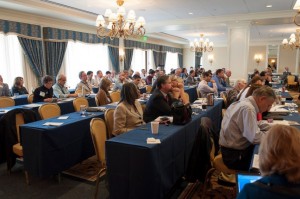
SAVE THE DATE FOR CWA’S 2015 SPRING CONFERENCE
May 13-15 at the Citizen Hotel, Sacramento


